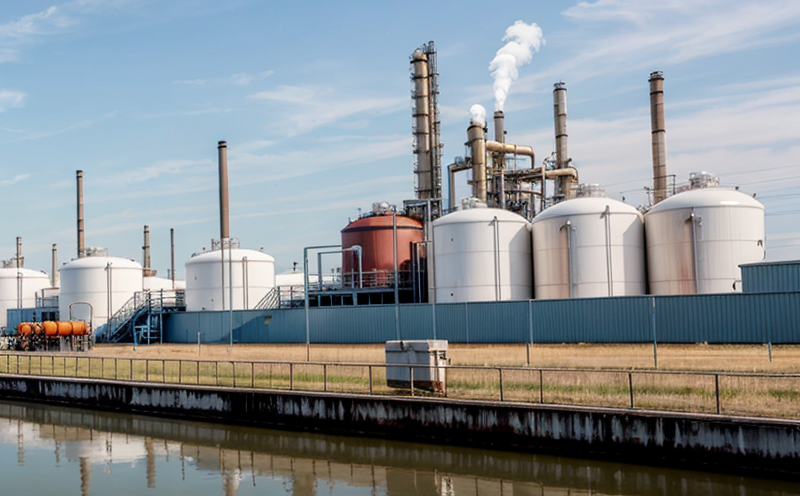JIS K0102 Industrial Effluent Safety Testing
The JIS K0102 standard is a critical component in the regulation of industrial effluents, ensuring that they meet stringent safety and environmental protection criteria set by Japan's Ministry of Economy, Trade, and Industry. This testing protocol is specifically designed to evaluate the potential hazards posed by industrial effluent discharges into water bodies.
Effluent from various industries can contain a wide array of contaminants, including heavy metals, organic compounds, and other toxic substances that are harmful to aquatic ecosystems and human health if not properly managed. Compliance with JIS K0102 is essential for businesses operating in Japan or those exporting goods to Japanese markets.
The testing process involves several key steps. First, the effluent sample must be collected according to precise guidelines outlined in the standard. The specimen should represent a representative portion of the total discharge and be free from any external contamination. Proper sampling techniques are crucial to ensure accurate results.
Once sampled, the effluent undergoes analysis using a combination of chemical and physical methods tailored to identify specific contaminants. Common tests include those for pH levels, conductivity, biochemical oxygen demand (BOD), chemical oxygen demand (COD), heavy metal concentrations, and organic compound detection. Advanced analytical instruments such as inductively coupled plasma mass spectrometry (ICP-MS) and gas chromatography-mass spectrometry (GC-MS) are often employed to achieve the necessary precision.
The results of these tests are then compared against established threshold values defined by JIS K0102. These thresholds vary depending on the industry type, discharge volume, and receiving water body characteristics. For instance, textile industries may have different permissible limits for dyes than those in the electronics sector. Compliance with these standards ensures that effluents do not cause significant harm to aquatic life or human health.
Compliance testing is just one part of the broader industrial process. It provides critical insights into the environmental impact of operations and helps guide continuous improvement efforts aimed at reducing harmful emissions. By adhering to JIS K0102, companies can demonstrate their commitment to sustainability and responsible business practices, thereby enhancing their reputation among consumers and stakeholders.
Failure to comply with this standard could result in severe penalties, including fines, operational restrictions, or even closure of facilities. Therefore, investing in reliable testing services is not only advisable but also necessary for maintaining good standing within the industry and fulfilling regulatory obligations.
In summary, JIS K0102 Industrial Effluent Safety Testing plays a vital role in safeguarding both public health and environmental quality by ensuring that industrial effluents meet stringent safety standards. Employing this testing protocol helps businesses navigate complex regulatory landscapes while promoting sustainable practices essential for long-term success.
Benefits
Compliance with JIS K0102 Industrial Effluent Safety Testing brings numerous advantages to your business. It enhances your reputation as a responsible corporate citizen, which is increasingly important in today's market where consumer awareness and expectations are growing.
By ensuring that your industrial effluents meet the stringent safety criteria set forth by this standard, you protect against potential legal issues and penalties associated with non-compliance. This can save your company substantial costs related to fines or operational disruptions.
Achieving compliance also opens up new market opportunities, particularly for businesses looking to expand into Japanese markets where adherence to local regulations is paramount. It signals to regulatory bodies that you take environmental responsibility seriously, which fosters trust and credibility among stakeholders.
Moreover, regular testing helps identify potential areas for improvement within your operations. Early detection of problematic effluents allows for proactive measures to be taken before they escalate into larger issues. This not only mitigates risks but also contributes positively towards reducing overall operational costs through more efficient resource utilization.
The transparency provided by adhering to JIS K0102 fosters better communication between your organization and various stakeholders, including regulators, customers, suppliers, and employees. Clear reporting on test results enhances mutual understanding and collaboration, leading to stronger relationships all around.
Industry Applications
The JIS K0102 Industrial Effluent Safety Testing is applicable across multiple industries that generate significant amounts of wastewater. These include but are not limited to:
- Textile manufacturing,
- Electronics production,
- Petrochemical processing,
- Agricultural chemical synthesis,
- Silicon wafer fabrication,
- Battery manufacturing,
- Pharmaceuticals production,
Each of these sectors contributes unique challenges when it comes to managing effluent safely and effectively. For example, the textile industry faces issues related to dye leaching into water bodies, while electronics manufacturers must address concerns about trace metal contamination.
In addition to manufacturing processes, certain service industries such as hospitals and laboratories also produce wastewater that requires careful handling. The stringent requirements of JIS K0102 ensure that all sectors operate within acceptable limits for environmental impact.
Use Cases and Application Examples
Let's delve into some specific scenarios where JIS K0102 Industrial Effluent Safety Testing plays a crucial role:
Scenario 1: Textile Manufacturing
A leading textile company in Japan was faced with stringent regulations regarding the discharge of effluents containing synthetic dyes. By implementing rigorous testing protocols based on JIS K0102, they were able to reduce dye concentrations significantly while still maintaining colorfastness standards.
Scenario 2: Electronics Production
An electronics firm encountered difficulties meeting BOD and COD limits set by local authorities. After adopting comprehensive monitoring practices aligned with JIS K0102, they achieved compliance through process optimization and improved wastewater treatment systems.
Scenario 3: Petrochemical Processing
A major petrochemical plant struggled to eliminate trace amounts of heavy metals from its effluent. Through advanced testing techniques recommended by JIS K0102, the company identified specific contaminants and developed targeted remediation strategies.
In each case, adherence to JIS K0102 provided valuable data that guided corrective actions and ultimately led to successful outcomes.





